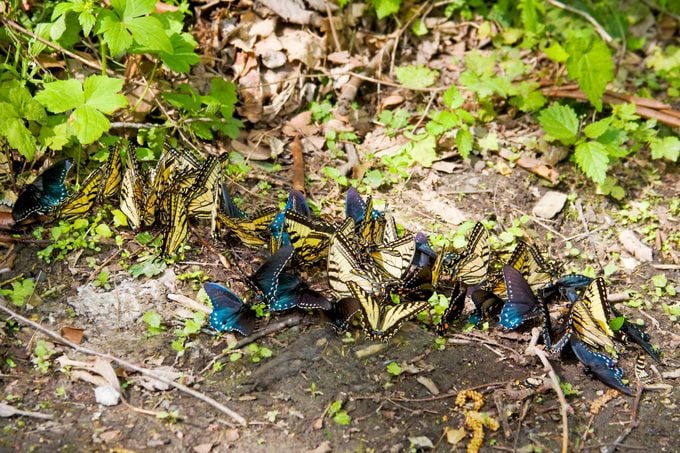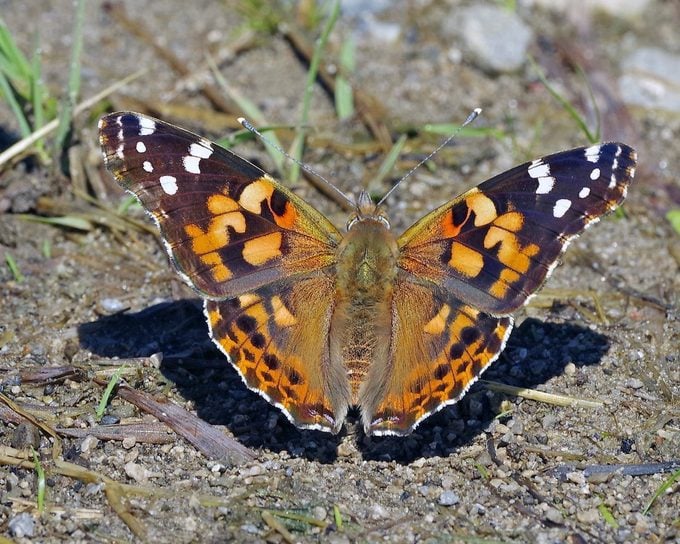How to Make a DIY Butterfly Puddler
Updated: Mar. 21, 2024
Learn why butterflies are attracted to puddles, which ones you might see in soggy areas, and how to create a DIY butterfly puddler.

Most of us see backyard butterflies fluttering in bright sunny gardens but, occasionally, you’ll find groups in unexpected places like a patch of mud, sandy riverbank or a DIY puddle station, which is called a butterfly puddler. Butterflies need sweet nectar from gardens to give them energy, but they also need the nutrients from these soggy areas.
How to Create a DIY Butterfly Puddler
Help butterflies, especially during dry weather, with a DIY backyard butterfly puddler spot.
- Find and fill a shallow dish or container with soil or sand. Add a few flat rocks to provide perching spots.
- Pour enough water in the container to moisten the soil, and sprinkle some salt on the surface. Also set out overripe fruit like bananas and oranges.
- Keep the soil moist during the heat of the day, when butterflies are more likely to visit.
Follow these tips for watching and photographing butterflies.
What Is Butterfly Puddling?
Butterfly puddling is when a butterfly visits and gathers nutrients from a puddle, usually as part of a larger group. A closer look will reveal they are likely males.
“Male butterflies, just like any living creature, are trying to ensure they reproduce,” explains Ryan Fessenden of the Florida Museum of Natural History’s Butterfly Rainforest. “One of the ways they do that is by passing on nutrients, along with genetic material, to the females when they are mating.”
When butterflies mate, males transfer a spermatophore to the females. Think of this as a tiny package that holds just about everything a female needs to produce healthy fertilized eggs. These spermatophores can be very large relatively, making up as much as 10% of a male butterfly’s weight. Part of the package includes nutrients that help support the female butterfly’s health, making her offspring more likely to survive.
“Male butterflies gather those nutrients by drinking water from wet spots on the ground, collecting various minerals and nutrients such as sodium and amino acids,” Ryan says.
Follow the stages of the monarch butterfly life cycle.
Where Do Butterflies Puddle?
And it’s not just the mud that attracts butterflies. Like other animals, butterflies need salt in their diet, and they find it in some very unexpected spots. “You may find a butterfly seeking out these valuable nutrients in other unusual locations, such as in tears on a crocodile or in sweat on human skin,” Ryan says. They’re also drawn to less savory items such as decaying flesh and excrement. There’s even a group of moths in Central America that puddle on blood.
Off-putting as it may seem, these behaviors are vital to their survival. That’s why you may see huge swarms of dozens or even hundreds of butterflies when a good puddling spot appears. “The more males that can gather nutrients, the more success the species will have reproducing,” Ryan says. “So when a wet spot or puddle is found by one, other butterflies will notice and join in.”
Check out 10 beautiful butterfly pictures you HAVE to see.

Which Butterflies Use a Puddler?
Any type of butterfly can use a puddler, but it’s most common in members of the swallowtail family (like these common swallowtails you should know), sulphurs and whites. In particular, look for tiger swallowtails, red-spotted purples, white admirals, cabbage whites, and clouded and cloudless sulphurs at butterfly puddlers. They are all there for one reason—to ensure they survive and thrive for many generations to come.
Next, check out myths and facts about butterfly host plants.
